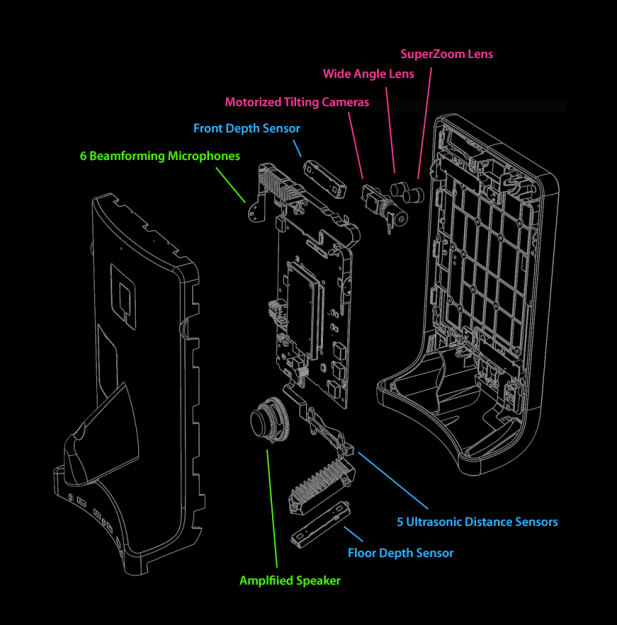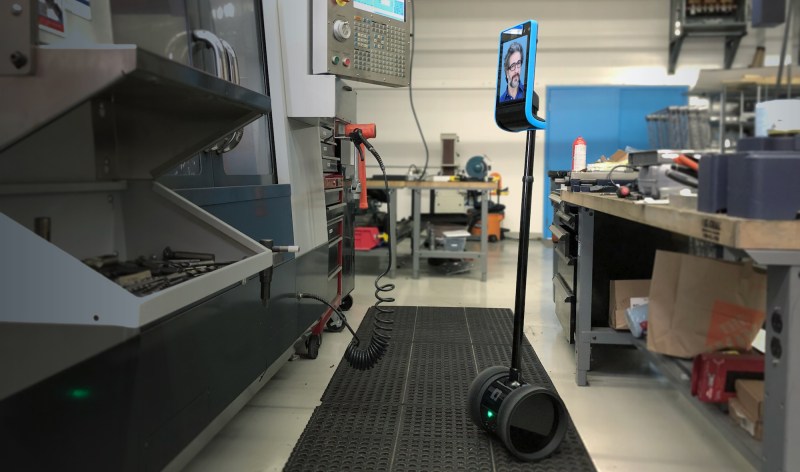Telepresence is one of those futuristic buzzwords that’s popped up a few times over the decades; promising the ability to attend a meeting in New York City and another in Tokyo an hour later, all without having to leave the comfort of your home or office. This is the premise of Double Robotics’ Double 3, its most recent entry in this market segment, as the commercial counterpoint to more DIY offerings.

Looking like a tablet perched on top of a Segway, the built-in dual 13 megapixel cameras allow the controller to get a good look at their surroundings, while the 6 beamforming microphones should theoretically allow one to pick up any conversation in a meeting or on the work floor.
Battery life is limited to 4 hours, and it takes 2 hours to recharge the built-in battery. Fortunately one can just hop over to another, freshly charged Double 3 if the battery runs out. Assuming the $3,999 price tag doesn’t get in the way of building up a fleet of them, anyway.
Probably the most interesting aspect of the product is its self-driving feature, which has resulted in a whole range of sensors and cameras (Intel RealSense D430 stereo vision depth sensors) being installed. To handle the processing of this sensor data, the system is equipped with an NVidia Jetson TX2 ARM board, running Ubuntu Linux, which also renders the mixed-reality UI for the user with way points and other information.
Currently Double Robotics accepts sign-ups for the private beta of the Double 3 API, which would give developers access to the sensor data and various autonomous features of Double 3’s hardware. Co-founder of Double Robotics, [Marc DeVidts] stated to Hackaday that he is looking forward to seeing what people can build with it. Hopefully this time people will not simply take the thing for a joyride, like what happened with a predecessor of the Double 3.
















I really hate to be “That” guy, but I can see no point to this over video conferencing. The only exception is a boss who wants to make his employees nervous by cruising this around the office when they are away on business…
I get your point. But wouldn’t it be funny to see you supervisor rolling into the room with his/her “Telepresence” (display on a stick) and then suddenly one of the wheel blocks (because the is a cable in the way or the floor is uneven) and your supervisor slams it face (actually display) into the floor. Wouldn’t that be hilarious?
Now it’s (most likely) the employees job to make sure the floor is clear of obstructions, but after of few of these “accidents” the system will fade out of existence pretty fast.
I’m sure it will be fun for a few days…
I foresee drone based equivalents of this tech – with the head hovering in front of you imaged on a see-through display to give a pseudo hologram effect.
Right, off to the patent office!
Or if he’s like Lumbergh in office space hovering around, taking status, telling physical employees to work weekends, just pick it up and put him in a utility closet. Just make sure he can’t see who did it.
…and include your mandatory cover sheet for the TPS report.
This is great. I cannot wait to put a “Kick Me” sign on its back!
> NO MATTER WHERE YOU ARE
Well. I am in Germany. Which means: Almost no internet connectivity even if you are on a landline. Not to speak about mobile usage. So “no matter where you are” immmediately renders this article an april-fool’s joke from the headline on downwards.
Having to do A LOT of video conferencing I can tell you first-hand-experience: It sucks big time. It has NO resemblance to “the real thing”. Video resolution isn’t good enough with internet-video-confing, lag is a HUGE issue, sound quality is poor, the lack of being able to quickly glance from side to side (using that mechanical device called a “head” on your neck) …
FORGET IT. IT IS HORRIBLE. Even a phone call can be more productive than a video conference.
“I like to watch…”.
There is absolutely a market for this thing. :-)
Christoo,
it’s not the office, it’s manufacturing or the lab where this would make sense.
As someone who has gained experience as application engineer, I can say with confidence that seeing a site in person or someday via a telepresence device is way more productive for problem- solving than any photo or (often insufficient) description.
Nevertheless, I would appreciate a more direct feedback, e.g. using a 6 DOF VR-headset,
but this would require a much more sophisticated equipment (e.g. omnidirectional wheels, a camera array & software which allow direct visual feedback for head movements, like leaning forward).
Unless this isn’t achieved (and this is pretty hard to achieve), you’ll unlikely feel to be there.
It would be cheaper to have a lot of IP cameras instead of that robot. That said, I’m sure it can be built for way cheaper when it’s basically a tablet mounted on a hoverboard.
Lots of open problems indeed. We recently published some early work on VR telepresence that uses a handheld RGBD camera to build a full 3D model of the site and broadcast it to remote exploration clients where it can be viewed with zero-latency response to head movement. Model resolution is quite low and we need to do all kinds of tricks to make it work, but still, I think of it as a first milestone to be able to do such remote inspection tasks at all. Check it out: http://cg.cs.uni-bonn.de/en/publications/paper-details/stotko2019slamcast/ (with video)
Note that this is about teleporting to /places/, not to /people/.
do a persistence of vision hologram around the mobile broom stick….hmmmm.
This reads like an ad or press release. Why is it on hackaday? Did I not read closely enough?
It’s an interesting product, there’s technical info available on how it works, and it’s from a company that’s been covered on the site before. But don’t let any of that get in the way of you complaining.
“Hopefully this time people will not simply take the thing for a joyride, like what happened with a predecessor of the Double 3.”
I think it was a veiled invitation to try your best to take the new version for a joyride.
Wishful thinking. Fantasy.
Executives and managers all are constantly traveling and seeking that face to face contact. Travel to the headquarters, to the little hole in Timbuktu, it doesn’t matter. Human contact is primordial.
I do not know why but there seems to be a NEED to travel, to physically go and get human face to face interaction.
Telepresence (Remote presence) has been around for a bloody long time. Sadly never took off. I don’t know why.
Simple. Doing it well = $$$$